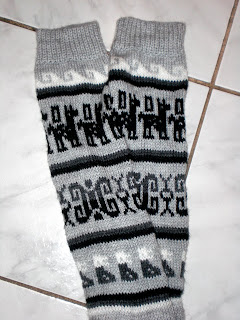After lunch we headed to the monument, which had been turned into a theme park of sorts with a variety of tourists shops, a stage with some not-so-entertaining singing, and several little museums around. It cost two bucks to get in, which was a racket to go stand by the monument and put your feet on either side of the line, but we did it nonetheless. They also had some alpaca-type animals just wandering around at will.
Sunday we left the hostal at 7 am for a two hour ride to Otavalo, a town north of Quito known for its traditional artisan street market. The bus ride was longish through some rather harrowing mountain roads, but the market was a site to see. Most of the vendors are indigenous people, and the majority of goods are hand-made. The best part was the bargaining- the vendor names their price and you go down from there; some are harder to buy down than others, but Lauren and I got some sweet socks for $2.50 a piece instead of $4.50. Also, I bought a pair of awesome hand-knit slippers, but the man charged me more because he said I had big feet! Oh well, they are definitely worth the $5.50 I paid.
The fun and games will soon be over however. We are getting down to business on our survey questions, trying to make sure we are as specific as possible while using language most of the farmers will understand. It's a challenge, to say the least. Tomorrow we are taking our questions for a test-drive, I have a feeling we'll be editing quite a bit after our first experience interviewing farmers. Meanwhile, the schedule is starting to wear on me- I have what is either bad allergies and/or a head cold and could use with about twelve hours of sleep, and I hear a couple of other sniffles in the group. Also, some of us sent out our laundry to the lavandaría to be washed on Friday, but I didn't realize it wouldn't be done until Monday. The launders weigh the laundry and charge by the weight for washing and drying and ironing, and I can't wait to have fresh clean clothes tomorrow. It's the small things in life that count, right?
































